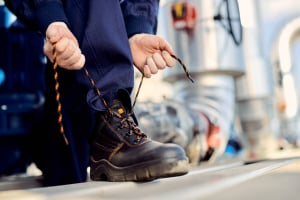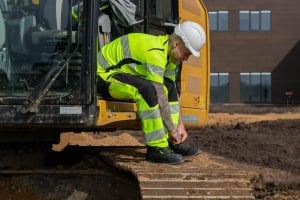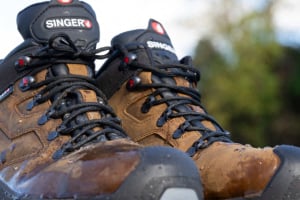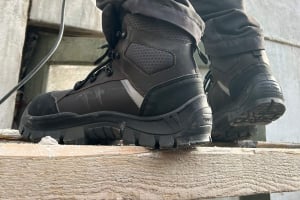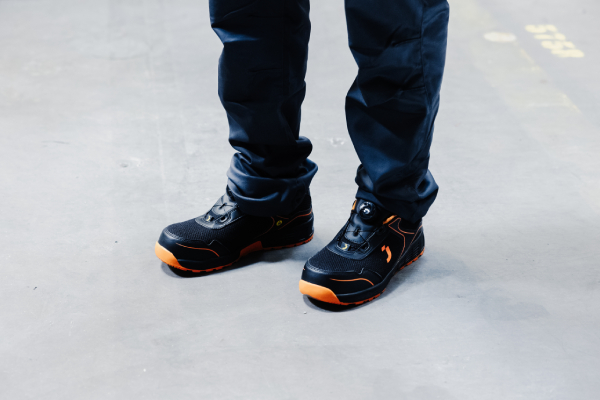
The importance of non-slip shoes at work
Every day, you face environments with varied challenges and potential risks. Whether you operate on a construction site, in a restaurant kitchen, or within a manufacturing facility, safety is a top priority. At the heart of this quest for well-being and prevention, safety shoes play a vital role. In recent years, the evolution of standards and collective awareness have highlighted the crucial importance of non-slip shoes in the professional context. It is through the non-slip soles, the compliance with safety standards and the comfort they offer that the work shoes stand out as a fundamental element of individual protection.
So what's so special about them? What standards govern their design? And how to make the wise choice of your pair of shoes? This article reveals the underside of this protective equipment and guides you towards the best choice for your feet, in complete safety.
Summary
Select the right pair of safety shoes
When it comes to selecting a safety shoe for your workplace, the criteria are many. The sole plays a leading role, as it is what keeps you stable on different floors. A non-slip sole is therefore essential to prevent falls and slips, which represent a large proportion of workplace accidents. But how do you find your way among acronyms like SRA, SRB and SRC?
A non-slip sole is characterized by its ability to resist slipping on wet or oily floors. The SRA and SRB standards are indicators of the anti-slip performance of a sole. The SRA standard concerns resistance on ceramic floors with water and detergent, while the SRB applies to steel surfaces with glycerin. A sole that meets the SRC standard combines the criteria of both, thus providing increased protection.
Technology for security
Safety shoes have evolved considerably, incorporating innovative materials and cutting-edge technologies to ensure foot protection. Soles are now designed with advanced material blends, such as polyurethane or nitrile rubber, providing strength and flexibility. Quick lace systems, protective shells and even anti-perforation soles increase the safety of your feet.
But the technology doesn't stop there. Some models integrate sensors that analyze posture and gait, making it possible to anticipate and prevent the risk of falls. Ventilation is also a key factor, with breathable materials that prevent overheating and discomfort, while maintaining foot hygiene.
Comfort and ergonomics: crucial for performance
Comfort is an aspect often underestimated when choosing safety shoes. However, it is essential to guarantee not only well-being, but also performance at work. An uncomfortable shoe can cause pain, fatigue and affect your concentration, thus indirectly increasing the risk of accidents.
A good work shoe must therefore offer good cushioning to absorb shocks, a shape adapted to the morphology of the foot, as well as flexibility which accompanies the natural movement of walking. Manufacturers now offer ergonomic ranges, with models designed for specific body shapes, taking into account the differences between male and female feet, for example.
When fashion meets safety
Safety shoes are no longer what they used to be. Gone are the days when aesthetics and safety did not go well together. Today, manufacturers are competing in creativity to offer models that combine style and protection. From high-top safety shoes with an urban look to safety trainers colorful, there is something for everyone.
This aspect may seem superficial, but it contributes to the acceptance and regular wearing of safety footwear. Workers are more likely to wear gear that they like and reflects their personality, which increases adherence to safety measures and reduces the chances of non-compliance with safety instructions.
New standards and regulations
Safety standards for work footwear are constantly evolving, in response to new risks and user feedback. European regulations specify requirements for personal protective equipment, and safety footwear must meet strict standards, such as ISO 20345 standard.
This standard defines the basic characteristics of safety shoes, such as the resistance of the soles to puncture or the protection of the toes against impacts. Keeping up with regulatory developments is crucial to ensuring that the safety footwear you choose provides adequate protection and complies with legal requirements.
The importance of non-slip shoes in the workplace cannot be underestimated. They are a major asset for the safety, health and performance of workers. Choosing the right pair means investing in your safety and comfort, and therefore, in your professional future.
In conclusion, non-slip shoes are more than an accessory, they are a necessity in the modern work environment. Choosing a suitable pair of shoes is a decisive step towards preventing accidents and injuries. It's not just about complying with standards such as the SRC, but also ensuring that every step at work is taken with confidence, without fear of slipping or falling. p>
It is your responsibility to select work shoes that meet the requirements of your job and your work environment, but also that fit you well, are comfortable and, why not, reflect a little of your personality. Ultimately, safety shoes are an investment in your well-being and efficiency at work. So be sure to make the wisest choice to get through your working day safely.


